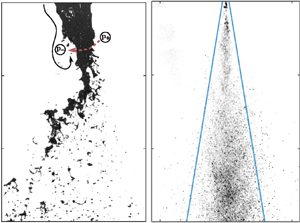Article contents
Spray dispersion regimes following atomization in a turbulent co-axial gas jet
Published online by Cambridge University Press: 09 December 2021
Abstract

A canonical co-axial round-jet two-fluid atomizer where atomization occurs over a wide range of momentum ratios:  $M=1.9 - 376.4$ is studied. The near field of the spray, where the droplet formation process takes place, is characterized and linked to droplet dispersion in the far field of the jet. Counterintuitively, our results indicate that in the low-momentum regime, increasing the momentum in the gas phase leads to less droplet dispersion. A critical momentum ratio of the order of
$M=1.9 - 376.4$ is studied. The near field of the spray, where the droplet formation process takes place, is characterized and linked to droplet dispersion in the far field of the jet. Counterintuitively, our results indicate that in the low-momentum regime, increasing the momentum in the gas phase leads to less droplet dispersion. A critical momentum ratio of the order of  $M_c=50$, that separates this regime from a high-momentum one with less dispersion, is found in both the near and far fields. A phenomenological model is proposed that determines the susceptibility of droplets to disperse beyond the nominal extent of the gas phase based on a critical Stokes number,
$M_c=50$, that separates this regime from a high-momentum one with less dispersion, is found in both the near and far fields. A phenomenological model is proposed that determines the susceptibility of droplets to disperse beyond the nominal extent of the gas phase based on a critical Stokes number,  $St=\tau _p/T_E=1.9$, formulated based on the local Eulerian large scale eddy turnover time,
$St=\tau _p/T_E=1.9$, formulated based on the local Eulerian large scale eddy turnover time,  $T_E$, and the droplets’ response time,
$T_E$, and the droplets’ response time,  $\tau _p$. A two-dimensional phase space summarizes the extent of these different regimes in the context of spray characteristics found in the literature.
$\tau _p$. A two-dimensional phase space summarizes the extent of these different regimes in the context of spray characteristics found in the literature.
Information
- Type
- JFM Papers
- Information
- Copyright
- © The Author(s), 2021. Published by Cambridge University Press
References
REFERENCES
- 10
- Cited by


